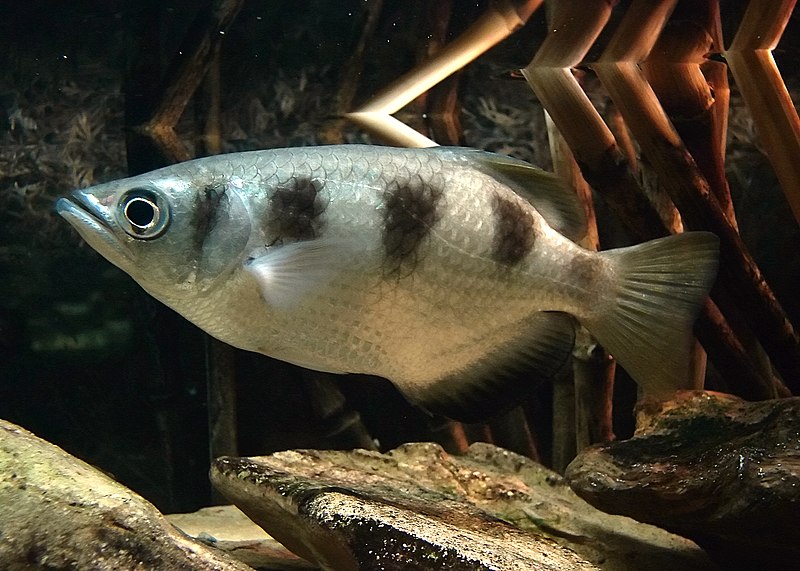
Please welcome back Frank Indiviglio to That Fish Blog.
Those with an interest in unique aquarium fishes need look no further than the mudskipper. These odd little creatures seem to straddle the line between fishes and amphibians, leaving the water for long periods of time to chase insects across mudflats and even climbing up onto tree trunks.
Mudskippers, the largest species of which reach a length of 12 inches, inhabit tidal flats, river mouths and mangrove swamps in East Africa, Southeast Asia, Australia, and along the Red Sea.
The mudskippers are unusual in having highly modified pectoral, pelvic and anal fins that enable them to move about quite well on land – they can even leap (“skip”) about very rapidly. In addition, the fused pectoral fins form a suction disc that allows these little acrobats to climb up onto mangrove roots and tree trunks. The eyes are situated at the top of the head and are, for a fish, quite movable.
Gill covers tightly seal the gill chambers, and water stored there keeps the gills moist and provides oxygen to the fish as it scuttles about on land. Mudskippers also absorb moisture from the damp mud upon which they usually travel when out of water. Although it is tempting to think of mudskippers as representing an early stage in the development of amphibians, the creature that gave rise to frogs and salamanders was more like the Australian lungfish, Neoceratodus fosteri, in appearance and in its method of breathing (utilizing primitive lungs).
The most commonly available mudskipper in the pet trade is Periopthalmus barbarus, a fairly hardy species that reaches a length of 6 inches. Like all mudskippers, it hails from brackish water areas.
Mudskippers are fairly tolerant in their salinity requirements, and will do well under typical brackish water aquarium conditions (salinity of 1.005-1.015) and temperatures of 75 – 80F. They require a “beach” area, which can be a separate, drainable plastic container within the main aquarium or designed as small islands fashioned from non-toxic tree roots, coral heads and rocks. The popular “aqua-terrariums” now on the market make excellent mudskipper homes as well. Remember to keep the water shallow, or to provide easy access to land, as they are poor swimmers (not something you usually worry about when keeping fish!).
Most mudskippers do well in captivity if provided with a suitable habitat. Males, however – distinguished by their large dorsal fins and bright colors – are very territorial, and dominant specimens will make life miserable for others, so plan your group and space accordingly.
Although they prey upon live invertebrates such as crabs and insects in the wild, mudskippers adjust well to frozen foods such as prawn and clams. I also provide a vegetable-based frozen food from time to time, and find they accept this readily as well. Their food should be placed on land, as most species will not feed while submerged. Mudskippers are especially fond of live crickets, small shrimp and other such foods, and these should form a large portion of their diet. Their acrobatics when chasing live food – they often flip over in their excitement – never fail to delight me.
Brackish water community tanks containing mudskippers and fiddler crabs make fascinating exhibits. The interactions between the crabs and mudskippers (assuming they are properly matched in size!) go on all day long. If you establish a deep water area (mudskippers will do okay as long as they can exit the water easily) you can add such fascinating fishes as four-eyed fish, Anableps spp., scats, Scatophagus argus and rubrifus, monos, Monodactylus argenteus, and, of course, the amazing archer fish, Toxotes chatareus. In fact, archer fish are at their best in an aquarium containing a land area because in such they can show off their incredible ability to knock crickets from land into water. Somehow compensating for the refraction of light through water, archerfish eject streams of water at insects (best observed by placing crickets on branches positioned over the water’s surface), hitting them unerringly and thus securing a meal. They will also aim water at your eye movements, so be careful!
I’ll cover the creation of such aquariums in future articles. Until then, please share your observations and write in with your questions. Thanks, Frank.
For more information on establishing aquariums for brackish water fish, please see the article Brackish Water Basics, posted on on February 26, 2008:
 Hello, Frank Indiviglio here. In the early 1980’s, I had the good fortune of being chosen to help set up the exhibits in Jungle World, a new Bronx Zoo building highlighting Southeast Asian wildlife. Leaf Insects, Sunbirds, Marsh Crocodiles, Giant Soft-shell Turtles, Proboscis Monkeys, Tapirs…all came under my care, but it was a mangrove marsh exhibit that became my favorite. It housed a variety of unique animals, including Mudskippers, Fiddler Crabs and Monos, but the real stars were a school of Banded Archerfish (Toxotes jaculatrix). Visitors especially enjoyed watching me service the exhibit…the Archerfishes would invariably squirt water at the movement of my eyes as I looked down at them, and they never missed!
Hello, Frank Indiviglio here. In the early 1980’s, I had the good fortune of being chosen to help set up the exhibits in Jungle World, a new Bronx Zoo building highlighting Southeast Asian wildlife. Leaf Insects, Sunbirds, Marsh Crocodiles, Giant Soft-shell Turtles, Proboscis Monkeys, Tapirs…all came under my care, but it was a mangrove marsh exhibit that became my favorite. It housed a variety of unique animals, including Mudskippers, Fiddler Crabs and Monos, but the real stars were a school of Banded Archerfish (Toxotes jaculatrix). Visitors especially enjoyed watching me service the exhibit…the Archerfishes would invariably squirt water at the movement of my eyes as I looked down at them, and they never missed! That Fish Blog – Aquarium Advice and Information
That Fish Blog – Aquarium Advice and Information


